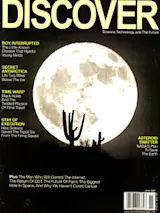Astronomers at the University of Minnesota have identified the largest known void in the universe, a cosmological no-man’s-land where stars, planets, and even dark matter are mysteriously absent. “It’s like an ice-cream scoop taken out of the universe,” says Shea Brown, one of the astronomers. “There’s nothing there.”
Detecting nothing—even when it’s 1 billion light-years wide—is not easy. It took observations of radio galaxies, temperature, and a bit of conjecture. Lawrence Rudnick, the astronomer who led the team that found the void, was studying data from the Very Large Array, a network of 27 radio antennas in New Mexico, when he spotted a gap in the constellation Eridanus where radio signals from galaxies appear unusually faint. He matched this gap with an enormous “cold spot”—colder than the frigid temperatures of deep space—in the cosmic microwave background, the leftover radiation from the Big Bang. “We knew we could connect these two things, the lack of radio galaxies and the cold spot,” Brown says. “It’s the easiest explanation—you don’t have to invoke any strange cosmologies to explain it.”
While voids are common in the universe, the average size is one-tenth the size of the void discovered by Rudnick and his team. The giant void is so weird he worries its size might be an illusion. “The history of science says that we would be silly to think that this [explanation of the void] is the end of the story,” Rudnick says. “It’s going to be up to the community and ourselves to try to challenge the conclusions we reach and see if they still hold up. Maybe we don’t have this whole story right yet.”














